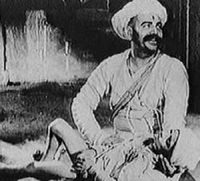 |
Sant Tukārām (1936/1948) |
"The Indian environment engendered, on the one hand, wild desires unrelated to ability and beyond all possibility of realization and, on the other, put infinite difficulties in the way of gaining even the most reasonable objects of desire, thus creating an intolerable feeling of frustration and sorrow. This was not mere disillusionment which cried
vanitas vanitatum, omnia vanitas, (Vanity, vanity, all is vanity) but an open, festering sore rankling day and night. The whole of Hindu philosophy was an attempt to rescue men from this mire of sorrow." (Nirad C. Chaudhuri,
Hinduism, p. 264).
It could be said, with equal justice, of the Hindi film that it too is an attempt - maybe distorted, ill-informed, exploitative, but taken as a cultural whole, a massive attempt - to rescue Indians from their "mire of sorrow".
The foundations of the popular Hindi film as it exists today were well and truly laid in the forties. Such foundations should be taken to refer to the financial structures of the industry as well as to the form and content of its product. These in turn were affected by the social, cultural, political and economic happenings of the forties.
In the forties, ‘lndia', so to say, was taken up by the scruff of its neck and brutally thrust into the modern age. We still suffer from the traumas of that decade, traumas that cannot be covered up by phrases like ‘glorious dawn of Independence'. If the current TV soap opera Buniyaad has one virtue, it is that it exposes the ugly face of the forties. A close study of this serial would greatly aid understanding of the forties and its cinema (in fact, Hindi songs of the forties are an important motif in Buniyaad.)
To put it briefly: The last gasp of the British Empire in South Asia coincided with its most brutal phase in India. Widespread neglect of the peasantry; total subjection of the basic needs of people to the war effort (the 1943 Bengal famine is only one example); and the bloody repression of the freedom struggle. A second and more disturbing feature of the forties was the economic participation of a section of the Indian bourgeoisie in the exploitation of their own people. Though Indian capitalism was well developed before the forties, the foundations of its present massive structure were, like that of the Hindi film, laid in the forties. On the surface, the capitalist class cooperated with political nationalism. But the war and famine meant super profits for some. As Prof. D.D. Kosambi [storico] remarks, in an article aptly entitled The Indian Bourgeoisie Comes of Age, "The really fantastic increase was not in production but in profits, particularly speculative gains through profiteering in food, share market operations and the black market in general - in short, the expression of a ravening greed".
One facet of this "ravening greed" was the increasing urbanisation, the uprooting of the rural masses, weakening of traditional values and adoption of the ethos of the West.
The last - perhaps the most important feature of the forties - was the increasing communal division - no longer a matter of riots but a separation of hearts and minds.
 |
Parosī (1941) |
Every one of these elements is reflected in the cinema of the forties through the prism of a traditional consciousness. It's for this reason that I have (admittedly arbitrarily) divided my discussion of the forties cinema into Religion, Romance and Revolt. ‘Religion' in the sense of an eclectic spectrum, embracing Bhakti, Sufism, and mythological archetypes -
Durga, Krishna, Ram. As Kumar Shahani [regista] said recently: "An archetype may contain within itself contradictions and diversities". The Hindi cinema abstracts one or other side of the archetype and adapts it to the needs of the hour. For what I broadly mean by ‘romance', I could as well cite the title of a recent book edited by Kakar and Ross,
Tales of Love, Sex and Danger. By ‘revolt', I refer not merely to empirical radicalism, but also to millenarian visions. An important point to be noted is the interflow between these three concepts in Hindi films. What is called a formula or
masala was, at the beginning, an acknowledgement of the inevitable intertwining of these elements in Indian popular culture.
Before I go into an examination of selected films under each head, I shall refer in passing to an important but difficult issue: The relation between the form of the Hindi film industry and that of the cinema which is its product. Someone else must deal with that question. Here, I would only refer very summarily to the question as posed in the West: Is cinema a product of a dream factory which is not the same as the product of an assembly line? On the ‘factory' side, uniformity is essential; on the 'dream' side, originality is important. The tension between the two is the Hollywood problem. I believe this to be true of the Hindi film too - with the difference that here the tension is both problem and essence. All the problems that plague the industry today first raised their heads in the forties. Infusion of black money into the industry; black payments to the stars; consequential changes in stars' lifestyles and their growing importance as 'consumerist' glamour models; growth of the ancillary gossip culture, feeding on the stars with demeaning effects both on stars, their performances and the readers; the shift of power to distributors and exhibitors with resultant pressure on producers to churn out formula films; the extinction of training programmes; the ‘suicidal' loans by producers.
All this too was reflected in cinematic themes and variations.
Religion - or rather religious culture - has always been an integral part of the Hindi popular film; I am not referring merely to elaboration of mythical archetypes but to an ethos, a temper, a tone. It is the variation on this theme that is one of the fascinating strands of Hindi cinema.
What distance have we travelled from the self-abnegation of Sant Tukaram (Marathi: 1936, Hindi: 1948) to the exhibitionistic self-flagellation of Coolie in the dargah shooting scene, or the self-prostration in the Mard temple scene, both in this decade? Still a path is beaten in all the three to the Indian psyche. 'New Cinema' neglect of this aspect, of ‘the cry of the soul in a soulless world' is one of the reasons of its failure in the popular arena.
Let's take two films. V. Damle and S. Fatehlal's Sant Tukaram is a big film in every sense - in the explosively spontaneous performance by V. Pagnis, in its matchless music, in the rendering of the"concise, vigorous, sometimes brutally knotted style" (J.T.F. Jordens) of the poet. But, above and beyond all this, I recall one specific sequence: Tukaram returns home and sees his wife and children ridiculously adorned in the finery gifted by the King. Tukaram in restrained but moving fashion brings home to them their greed and folly. It's not so much what he says, but the way the sequence is shot and played that's significant. The sequence shows up the moral inappropriateness of affluence amidst a culture of deprivation. Here is delivered a poetic and exquisite verdict.
Tukaram was the swan song of an age of innocence, of an age where the material consciousness of poverty was a moral fact. The destruction of that innocence was an important element of the forties. And in a sense that process is charted in Shantaram's Padosi (1941).
Padosi is generally regarded as a cautionary fable - a rather simplistic one - of the Hindu-Muslim problem. Today I look at it in a rather different light.
There are three basic movements in Padosi. Idyllic coexistence; divisive modernisation; integration achieved through an explosive act of love. Each of these is as powerfully relevant in 1987 as it was in 1941.
The first movement might be a continuation of Tukaram. Hindu and Muslim cultures are shown as distinct but lovingly co-existing. This is, of course, achieved through stylistic devices. Some of these are simplistic, even crude. But the vision is genuine. The vision is of an austere, simple, disciplining, self-abnegating Oriental religion. At a deep level, Shantaram achieves a unity of Hinduism and Islam based on material circumstance.
The westernised engineer, director of a metropolitan company, disrupts this harmony through 'modernisation' - he plans to sink the village for a dam. There's again stylization here but stylization in form and intention which is akin in spirit to Chess Players (Ray), Mohan Joshi Haazir Ho (Saeed Mirza) and Oridathu (Aravindan). Shantaram's emphasis is on how modernisation, whether it calls itself empire, central planning, or multinational, can destroy a delicately-balanced communal harmony and lead to 'anti-modernism' - religious revival.
The final scenes of Padosi - the union of the Hindu and the Muslim in death, in the apocalyptic scene of the dam burst - may seem embarassing today. But isn't such an apocalyptic act necessary in a desperate situation? If it had been a film, Gandhiji's martyrdom would have seemed as stagey as Padosi's finale.
There's one sequence in Padosi whose significance is generally missed. This is where a Muslim youth wanders at night amidst the brilliance of the Rakshabandhan festivities (the song refrain is Bhai Kahan Mera: Where is my Brother). He is fascinated, surprised, lost in a strange Eden. In that sequence, more than in any other 'integration' film before or after, Shantaram has gone to the heart of the Great Division: Brothers but Strangers.
To me, after a reviewing of Padosi, another later film about integration, Garm Hawa, seems a bit forced despite its other excellences and its contemporary relevance. Compare the finales. Farooque Shaikh's unobtrusive joining of a ‘Red' procession seems a trendy gesture, compared to the stagey but bolder and deeper finale of Padosi.
Note
Bhakti: lett. "devozione"; corrente devozionale che si sviluppa dapprima nell'India meridionale, tra il IX e il XIV secolo, e in seguito nel nord, nei secoli XV-XVII; movimento di rinnovamento religioso che contemplava un diretto rapporto d'amore tra l'uomo e dio (soprattutto nelle figure di Rām e Krishn, incarnazioni di Vishnu, il Preservatore nella Triade o Trimūrti, insieme con Brahmā, il Creatore, e Shiv, il Distruttore), è stato anche un momento di rinnovamento sociale e di grande importanza nella letteratura.
Durgā: l'Inaccessibile, uno degli aspetti terribili di Devī (Dea), consorte di Shiv.
Krishn: eroe della mitologia hindu di origini probabilmente non arie (raffigurato di colore blu, il nome significa "nero"), è considerato l'ottavo avtār o epifania del dio Vishnu.
Rām: re di Ayodhya ed eroe del poema epico Rāmāyan; considerato la settima epifania del dio Vishnu.
Sufism: da sūf, la rozza veste di lana che indossavano i sūfī, mistici musulmani; il sufismo è una delle correnti dell'islam che più profondamente si radicano in terra indiana, forse per le somiglianze tra certi aspetti del sufismo e alcune sette hindu, come la meditazione e il controllo del respiro tipici degli yogī, l'importanza del maestro come nel tantrismo, il rapporto d'amore tra dio e l'uomo e la ricerca dell'unione col divino. Sufismo e bhakti si sono influenzati reciprocamente.
Masālā: lett. "spezie"; uno dei termini con cui viene definito il cinema popolare, ormai noto anche in occidente come "Bollywood".
Dargāh: lett: "soglia", "portale"; santuario o tomba di un santo.
Rakshābandhan: (da rakshā," protezione", "difesa", e bandhan, "legame") festa che si tiene durante il plenilunio del mese di sāvan (da metà luglio a metà agosto), durante la quale le ragazze legano la rākhī (da rakshā), un bracciale di filo, al braccio del fratello o di un uomo che da quel momento diventa loro fratello.